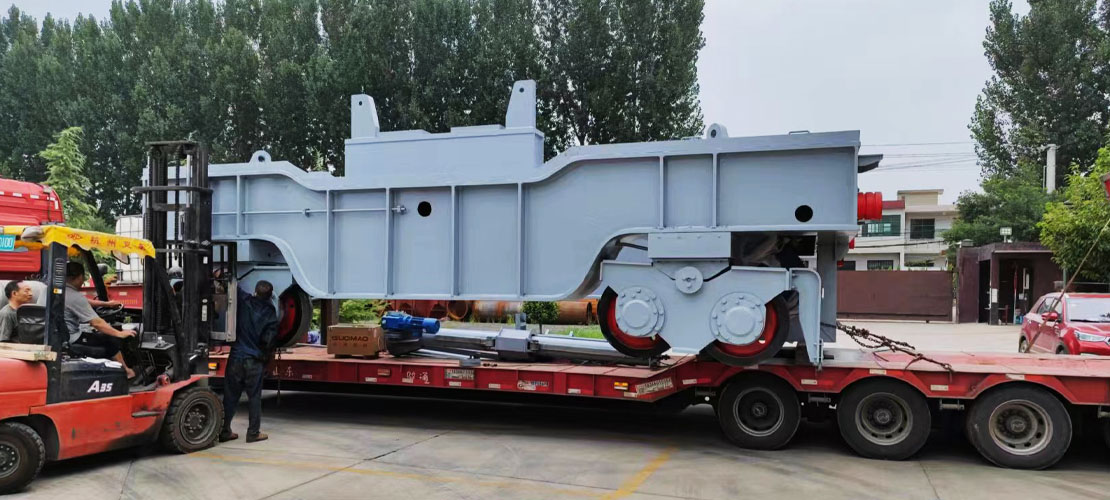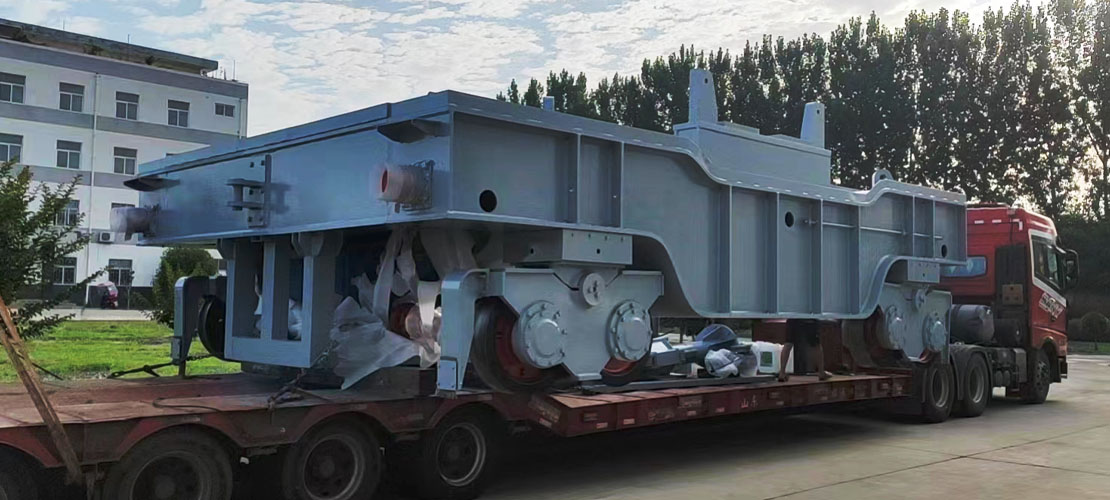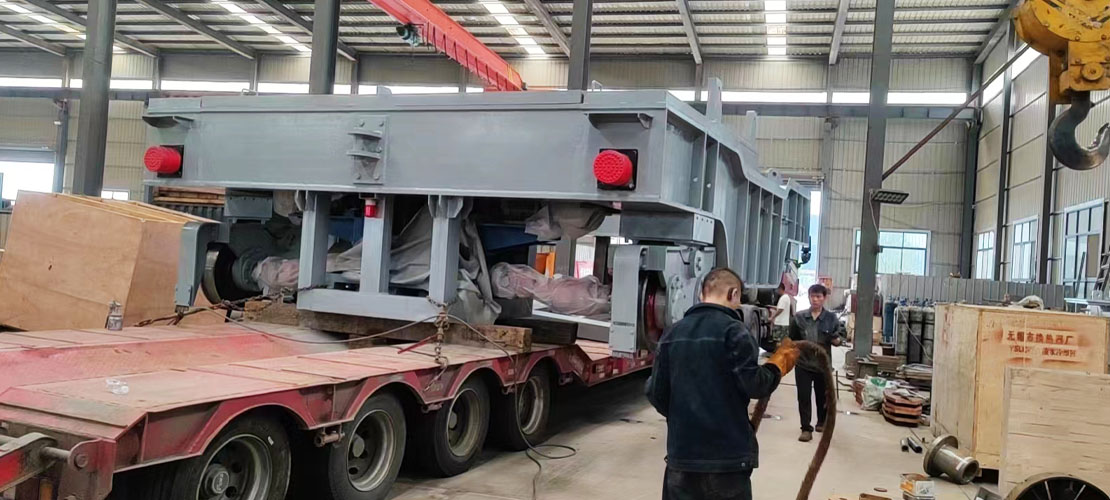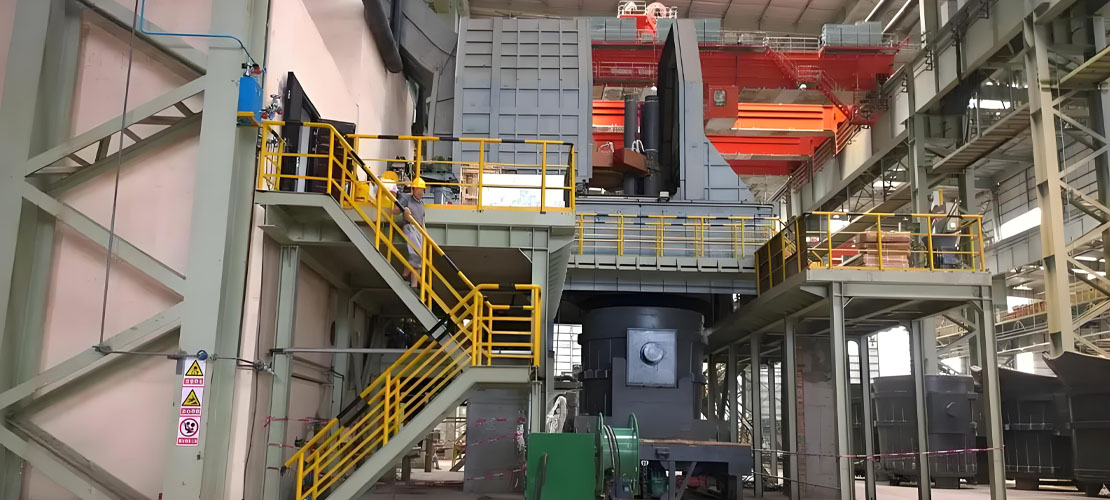Jun. 17, 2025
Ladle transfer truck, also known as ladle car, is a kind of electric flat car for molten steel and iron handling built for steel foundries. It has added special treatment when designing and is heat-resistant and high temperature resistant. Ladle transfer car is a special vehicle in the steel and metallurgy industry used to transport ladles containing high-temperature molten steel. It can operate safely and reliably in harsh environments such as high temperature, heavy load, and high dust.
Ladle transfer trucks can be customized according to the customer's required ladle load capacity and ladle size.
Due to the high temperature and high safety requirements, the requirements for car body materials, transmission systems, and electrical control of ladles are higher than those of ordinary transshipment vehicles.
Prevent steel or slag from coming out
To prevent splashing of steel or slag, the traction motor on the transfer truck is designed to start and stop slowly to reduce inertia.
In order to prevent the inclusion body temperature radiation, heat insulation material is provided in the vehicle body.
In order to better ensure the transportation of steel, under normal circumstances, a dual transmission system is used. Once one of the systems fails, the other one ensures that one process cycle can be completed.
Lat-up truck is a type of electric flat car. It is specially designed for steel mills to transport ladles safely and efficiently.
Use of ladle transfer trucks: widely used in steel mills, steel processing plants and other places. The refined steel water is transported to the casting span for mold casting or continuous casting. It can also be used as a transportation tool for transfer of each process station of the refining furnace to each other.

The body of the ladle car is made of special high-temperature and high-strength materials, which can withstand extremely high temperatures and weights of molten steel. The frame supports the entire vehicle body like a human bone, ensuring that there is no deformation or damage during transportation.
A set of operating transmission devices is installed between two beams at both ends of the vehicle body, and a heat insulation layer and protective cover are installed around the transmission device, effectively avoiding the thermal radiation of steel and steel slag and greatly improving the service life of the transmission device.
As an indispensable transportation equipment in steel mills, ladle charter trucks have a series of significant advantages and some disadvantages. The following is a detailed analysis of the advantages and disadvantages of ladle chartered vehicles:
Lat-up trucks can usually carry more than 30 tons of weight to ensure the safety of steel materials during transportation. This powerful load-bearing capacity allows ladles to cope with the transportation needs of various heavy goods.
Due to the extremely high temperature of steel, steel slag, etc., the ladle chartered vehicles are specially equipped with high-temperature and explosion-proof motors, and adopt heat-resistant and high-temperature-resistant car body materials and thermal insulation design. This design effectively prevents the inclusion body temperature radiation and ensures the stable operation of the equipment in a high temperature environment.
The ladle car is equipped with a number of safety protection measures such as braking system, anti-rolling system, collision rod, etc. These measures have played an important role in ensuring transportation safety and ensured the stable operation of ladle-up vehicles under complex road conditions.
The ladle car supports remote control operation, which avoids people from directly contacting the high-temperature ladle, greatly reducing work risks. This operation method not only improves work efficiency, but also ensures the personal safety of staff.
Lack-up vehicles have long life, low maintenance costs and strong adaptability, and can meet the needs of various road conditions and climatic conditions. This has made ladle chartered vehicles widely used in the steelmaking industry.
The movement of the ladle car is transmitted by the motor through the reducer and coupling, equipped with two driving wheels and driven wheels, achieving large-scale speed adjustment and high-speed shaft braking. This design makes the operation of ladle charter more flexible and convenient.
Ladle transfer trucks usually need to be customized according to the specific needs of users, such as the size, shape, weight, operating route of the ladle.
Lack-up vehicles have high requirements for track laying, and the track needs insulation treatment. This increases the complexity and cost of track laying.
When the operating distance exceeds a certain range (such as 70 meters), the number of transformers needs to be increased to compensate for the rail pressure drop. This increases the complexity of the equipment and the operating cost.
Since ladle charter uses special materials such as high temperature resistance and high strength and complex design processes, its equipment costs are relatively high. This increases the investment costs of the company.
To sum up, ladle charter has significant advantages and certain disadvantages in the steelmaking industry. When choosing and using ladle charter vehicles, enterprises need to make decisions in a comprehensive way to consider their advantages and disadvantages and actual transportation needs.

The power system of the ladle car is usually provided by a motor or hydraulic system. The motor drives the wheels to rotate, allowing the ladle to drive smoothly on the track. The hydraulic system plays a role in some operations that require precise control, such as the positioning of the ladle car and the tilt of the ladle bag.
Lat-up trucks are equipped with advanced control systems, which operators can control the start, stop, speed and driving direction of the ladle trucks. The control system must ensure the accuracy and timeliness of operation to avoid any possible dangerous situations.
Motor Drive: Usually driven by DC motor or AC variable frequency motor to provide the power for vehicle operation. The frequency converter motor can achieve smooth start, acceleration and deceleration, improving operational safety.
Reducer: Reduce the motor's high speed to a speed suitable for the vehicle's operation and increase torque.
Wheel Set: Transfers the power of the reducer to the wheels and drives the vehicle to run on the track. The design of the wheel set needs to consider load bearing capacity, wear resistance, and matching with the track.
Steel structure frame: To withstand the weight of the ladle and the impact force during operation, it needs to have sufficient strength and stiffness. Welded structures are usually used and undergo strict quality inspection.
Ladle bracket: Used to secure the ladle to prevent it from tilting or moving during transportation. The design of the bracket requires consideration of the size, shape and weight distribution of the ladle.
Leveling mechanism: Used to adjust the horizontal position of the ladle to ensure that the molten steel does not overflow. The leveling mechanism can be hydraulic, mechanical or electric.
Thermal insulation layer: Set a heat insulation layer between the ladle bracket and the frame to prevent high-temperature molten steel from causing damage to the frame.
Cable reel power supply: The power is delivered to the vehicle through the cable reel.
Sliding contact wire power supply: The power is delivered to the vehicle through the sliding contact wire.
Battery power supply: Use a battery as a power supply, suitable for occasions where flexible movement is required.
Low voltage rail power supply: transporting electricity to vehicles through insulated tracks

The design and manufacturing of ladle transfer trucks must attach great importance to safety and adopt various safety protection devices to ensure safe and reliable operation in harsh environments such as high temperature and heavy load.
Ladle transfer trucks need to run continuously for a long time, so they need to have high reliability, adopt high-quality parts and advanced manufacturing processes.
Ladle transfer trucks need to carry dozens of tons or even hundreds of tons of ladles, so they need to have strong load-bearing capacity.
Ladle transfer trucks need to withstand the radiant heat of high-temperature molten steel, so they need to use high-temperature resistant materials and heat insulation measures.
Automation control technology: Modern ladle transfer vehicles usually use PLC control, sensors, wireless communication and other technologies to achieve automated operation and improve production efficiency. It realizes precise operation based on the PLC control system, integrates sensors to monitor the vehicle speed, load and temperature, and is linked to the central control room through wireless communication.
The design of a ladle transfer truck needs to consider the convenience of maintenance, which is convenient for replacement of parts and daily maintenance.
The ladle is hoisted by a crane to the transfer truck, and the weighing system monitors the load in real time to prevent overloading.
The motor drives the vehicle to travel at a constant speed along the track, and the PLC system adjusts the speed and direction according to the preset path.
The vehicle stops to the designated position of the continuous casting machine or the smelting area, and smoothly unpacking it through hydraulic or mechanical devices to avoid the shock of the steel

Support remote control operation (handle or remote control): Lack-up vehicles usually have remote control operation functions, which allows staff to stay away from high temperature hazardous areas and improve operation safety and convenience.
The ladle car is equipped with a number of safety protection measures such as braking system, anti-rolling system, collision rod, etc. to ensure stable operation under various road conditions.
Dual braking system: Mechanical braking and electromagnetic braking work together to ensure rapid parking in emergencies.
Splash-proof design: Splash-proof baffle is installed in the transmission parts, and the traction motor adopts slow start-stop control to reduce the shaking and splash of steel.
Redundancy protection: dual circuit power supply, dual transmission system and other designs to reduce the risk of downtime caused by a single failure.
Latest News
Latest Products
Customized metallurgical machinery and equipment range: Electric Arc Furnace, Submerged Arc Furnace, LF Refining Furnace, Vacuum Furnace, Induction Furnace, Dust Remove System, Water Treatment Equipment, etc. Providing the most advanced equipment integration services, metallurgical equipment can be customized according to different needs of customers, and production capacity can be adjusted according to customer requirements.
Electric Arc Furnace
Submerged Arc Furnace
LF Refining Furnace
VD / VOD Vacuum Refining Furnace
Induction Furnace
Furnace Accessories
Navigation
E-mail: anna@srfurnace.com
Tel: +86 159 2955 5868
WhatsApp: +86 159 2955 5868
Add:
Room 102, Building 7A, Free Trade Xintiandi, Fengdong Avenue, Fengdong New Town, Xi'an City, Shaanxi Province
